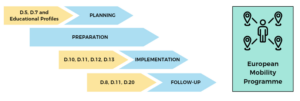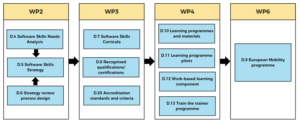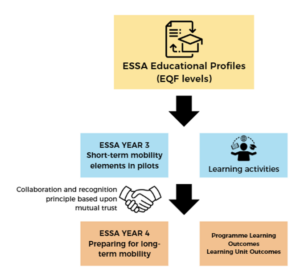This report provides an overview of the overall approach taken to mobility by the ESSA Alliance.
Following a brief discussion of the mobility in learning concept — seeing the primary aim of mobility in providing students and/ or teachers with an international learning and/ or teaching experience linked to a formal learning programme at their home institution — and ESSA taken approach to curricula, learning outcomes and EU-level recognition in the Introduction section, the heart of this report is structured by three main sections.
Figure 1. ESSA deliverables supporting a European Mobility Programme — Key stages
The first main section (Chapter 3) provides a brief overview of European instruments and tools that can be used to support learning mobility in general and the development of software professional competences in particular across Europe. Based on the mobility tools provided by the EU (e.g. Erasmus+ and Europass) and the sector-relevant frameworks and standards used by the Alliance, this section also explains how the ESSA educational tools and resources developed throughout the project cycle can be systematically used to support the successive phases of planning, preparation, implementation and follow-up of a European mobility programme.
Figure 2. ESSA key deliverables building upon each other in the project workflow
The second main section (chapter 4) reports on the elaborated methodology and the practical work carried out by the ESSA partners in the third Year in connection with the pilot phase of the ESSA learning programmes. In the third main section, the report concludes with a short outlook on the further work of the ESSA partnership on mobility in the fourth project Year 4, focussing on long-term sustainability.
Figure 3. The ESSA Educational Profiles offering entry points for short- and long-term mobility to the ESSA work in Year 3 and Year 4
DOWNLOAD (PDF)
Conclusions
This report provides evidence of collaborative efforts in addressing mobility aspects on various levels, from examining existing European mobility schemes and instruments, to how mobility is considered in the main ESSA outcomes, to the testing of short-term digital mobility in the ongoing ESSA pilot projects, and will conclude with an outlook on further work in ESSA Year 4.
Use of this report
This report serves the Alliance as a reference for further work on mobility in the fourth project year and also after the project has been completed. It can furthermore serve as an example and inspiration for other European initiatives dealing with the topic of mobility in European professional competences and skills development.



